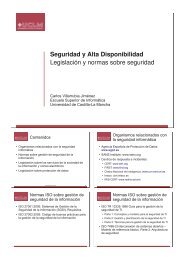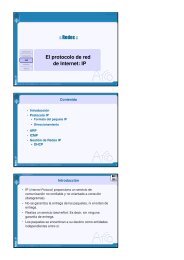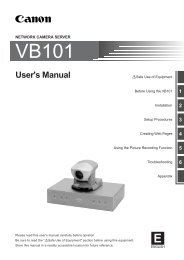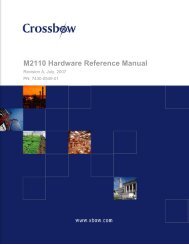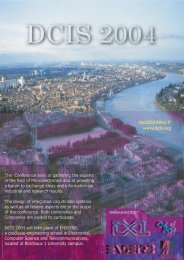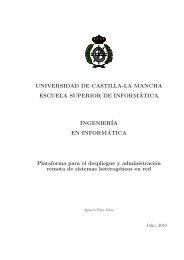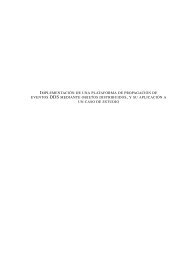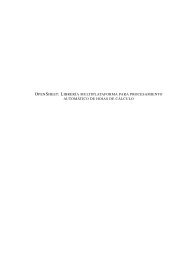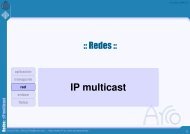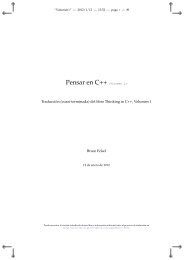Computer Networks I IP addressing
Computer Networks I IP addressing
Computer Networks I IP addressing
Create successful ePaper yourself
Turn your PDF publications into a flip-book with our unique Google optimized e-Paper software.
Version Mar 14, 2011<br />
<strong>Computer</strong> <strong>Networks</strong> I<br />
application<br />
transport<br />
network<br />
<strong>IP</strong> <strong>addressing</strong><br />
link<br />
physical<br />
David.Villa@uclm.es
<strong>Computer</strong> <strong>Networks</strong> I 2<br />
●<br />
●<br />
●<br />
●<br />
●<br />
●<br />
●<br />
●<br />
Introduction<br />
Special addresses<br />
Classful <strong>addressing</strong><br />
Private addresses<br />
Subneting<br />
VLSM<br />
Superneting<br />
Classless <strong>addressing</strong><br />
●<br />
CIDR<br />
Outline
<strong>Computer</strong> <strong>Networks</strong> I 3<br />
Introduction<br />
●<br />
●<br />
●<br />
The <strong>IP</strong> address is a 32 bit integer.<br />
The address identifies a connection point (a NIC).<br />
<strong>IP</strong> addresses are universally unique.<br />
● The <strong>addressing</strong> space is 2 32 = 4.294.967.296<br />
●<br />
A single host may have several interfaces and it<br />
must have an address per connected interface.
<strong>Computer</strong> <strong>Networks</strong> I 4<br />
Introduction<br />
●<br />
The <strong>IP</strong> address is usually represented as a<br />
sequence of 4 decimal numbers (0-255) separated<br />
with dots.<br />
161.67.136.169<br />
●<br />
But it may be represented as a binary sequence:<br />
10100001.01000011.10001000.10101001
<strong>Computer</strong> <strong>Networks</strong> I 5<br />
Introduction<br />
The <strong>IP</strong> address has two parts<br />
●<br />
●<br />
NetID, identifies the network (designed by a<br />
global authority) IANA (Internet Assigned<br />
Number Authority)<br />
HostID, identifies a host inside the network.<br />
subnet<br />
host<br />
32 bits
<strong>Computer</strong> <strong>Networks</strong> I 6<br />
Special addresses<br />
RFC<br />
3330<br />
0.0.0.0<br />
This host (any interface)<br />
11111111.11111111.11111111.11111111 All hosts: 255.255.255.255<br />
XX ... XX<br />
00 ... 00<br />
This network<br />
XX ... XX<br />
11 ... 11<br />
All hosts in this network<br />
00 ... 00 XX ... XX A host in this network<br />
01111111.X.X.X Loopback: 127.0.0.1
<strong>Computer</strong> <strong>Networks</strong> I 7<br />
Classful Addressing<br />
There are 5 classes, recognized by the MSB bits.<br />
RFC<br />
791<br />
0<br />
0 1 2 3 4 5 6 7 8 9<br />
1<br />
0 1 2 3 4 5 6 7 8 9<br />
2<br />
0 1 2 3 4 5 6 7 8 9<br />
3<br />
0 1<br />
0 net id<br />
host id<br />
A class<br />
10 net id<br />
host id B class<br />
110 net id<br />
host id C class<br />
1110 multicast groups<br />
D class<br />
1111 reserved for future use E class
<strong>Computer</strong> <strong>Networks</strong> I 8<br />
Classful Addressing<br />
Classes:<br />
●<br />
A: 2 31 addresses (50%) 1.0.0.0 - 127.255.255.255<br />
●<br />
B: 2 30 addresses (25%) 128.0.0.0 - 191.255.255.255<br />
●<br />
C: 2 29 addresses (12,5%) 192.0.0.0 - 223.255.255.255<br />
●<br />
D: 2 28 addresses (6,25%) 224.0.0.0 - 239.255.255.255<br />
●<br />
E: 2 28 addresses (6,25%) 240.0.0.0 - 255.255.255.255<br />
The IANA (Internet Assigned Numbers Authority) assignees address<br />
blocks. IANA depends on ICANN (Internet Corporation for Assigned<br />
Names and Numbers).<br />
i<br />
<strong>IP</strong>v4 address block assignments in:<br />
http://www.iana.org/assignments/ipv4-address-space/ipv4-address-space.xml
Private addresses<br />
RFC<br />
1918<br />
Some blocks are reserved for private <strong>addressing</strong> (privately<br />
administered). The packets with a private destination<br />
address must be not forwarded<br />
outside the network.<br />
10.0.0.0 -10.255.255.255/8<br />
●<br />
(16.777.216 hosts in 1 block)<br />
172.16.0.0 - 172.31.255.255/12<br />
●<br />
(1.048.576 hosts in 16 blocks)<br />
192.168.0.0 - 192.168.255.255/16<br />
●<br />
(65.536 hosts in 256 blocks)<br />
http://xkcd.com/742/<br />
<strong>Computer</strong> <strong>Networks</strong> I 9
<strong>Computer</strong> <strong>Networks</strong> I 10<br />
Link-local addresses<br />
RFC<br />
3927<br />
●<br />
It is a method to auto-assign an <strong>IP</strong> address without<br />
DHCP or other external service.<br />
●<br />
The host selects an address in the block<br />
169.254/16 using a pseudo-random number.<br />
●<br />
●<br />
These address are valid only to communicate with<br />
neighbors (same physical or logical link).<br />
These are not routable address.
<strong>Computer</strong> <strong>Networks</strong> I 11<br />
Classful <strong>addressing</strong><br />
Network address (net id)<br />
The network address:<br />
●<br />
●<br />
is the first address of its block.<br />
identifies the whole network from the Internet point<br />
of view.<br />
From any host address it is possible to know its<br />
network address, class and address range of the<br />
block.
<strong>Computer</strong> <strong>Networks</strong> I 12<br />
Classful <strong>addressing</strong><br />
Network mask<br />
The mask is a 32-bit integer that determines the net-id.<br />
network address = host address AND mask<br />
i<br />
It is a B class network<br />
161 67 38 13<br />
1010 0001<br />
0100 0011 0010 0110 0000 1101<br />
mask<br />
1111 1111 1111 1111 0000 0000 0000 0000<br />
network address<br />
1010 0001 0100 0011 0000 0000<br />
0000 0000
<strong>Computer</strong> <strong>Networks</strong> I 13<br />
Classful <strong>addressing</strong><br />
Network mask<br />
Default masks for the three classes<br />
A<br />
B<br />
C<br />
255 0 0 0<br />
255 255 0 0<br />
255 255 255 0<br />
●<br />
●<br />
●<br />
The mask is not required when we use classful <strong>addressing</strong> only.<br />
Other way to indicate mask is “CIDR notation”.<br />
Example: The mask 255.255.0.0 may be indicated like:<br />
● 161.67.27.38 /16
<strong>Computer</strong> <strong>Networks</strong> I 14<br />
Subnetting<br />
RFC<br />
950<br />
●<br />
●<br />
Problem: The A and B class networks are underutilized.<br />
Solution: Divide them in smaller sub-networks. Part of the host id<br />
is used to identify the sub-net.<br />
0<br />
0 1 2 3 4 5 6 7 8 9<br />
10 net id<br />
1<br />
0 1 2 3 4 5 6 7 8 9<br />
2<br />
0 1 2 3 4 5 6 7 8 9<br />
host id<br />
3<br />
0 1<br />
i<br />
RFC<br />
1878<br />
n bits -> 2 n subnet<br />
sub-net id<br />
● The scheme shows a 4-bit sub-net id. Therefore, there are 16<br />
subnets with 2 12 -2 hosts each.
<strong>Computer</strong> <strong>Networks</strong> I 15<br />
Subnetting<br />
●<br />
The number of subnets must be a power of 2.<br />
●<br />
●<br />
●<br />
It may be applied to any not-used block.<br />
That is a local decision, taken by the administrator. It is not perceived from<br />
outside.<br />
Sample: Apply subnetting to the next network to obtain 4 blocks:<br />
141.14.0.1 141.14.0.2 141.14.192.2<br />
141.14.255.253 141.14.255.254<br />
Red: 141.14.0.0<br />
141.14.201.4<br />
Conventional B-class network<br />
Internet
Subnetting<br />
sample (cont)<br />
<strong>Computer</strong> <strong>Networks</strong> I 16<br />
141.14.0.1 141.14.0.2<br />
141.14.63.254 141.14.64.1 141.14.64.2<br />
141.14.127.254<br />
Subnet: 141.14.0.0/18<br />
Subnet: 141.14.64.0/18<br />
X.X.0000 0000.0 X.X.0100 0000.0<br />
141.14.44.12<br />
141.14.88.9<br />
141.14.198.24<br />
141.14.128.1 141.14.128.2<br />
141.14.191.254<br />
141.14.192.1 141.14.192.2<br />
141.14.255.254<br />
Subnet: 141.14.128.0/18<br />
Subnet: 141.14.192.0/18<br />
X.X.1000 0000.0 X.X.1100 0000.0<br />
B-class network divided<br />
In 4 subnets<br />
141.14.167.20<br />
Internet<br />
141.14.201.4
Subnetting<br />
Subnet mask<br />
<strong>Computer</strong> <strong>Networks</strong> I 17<br />
●<br />
With subnetting routing is not possible without a mask that<br />
defines the subnet.<br />
● In the previous sample<br />
host id<br />
0<br />
1<br />
0 1 2 3 4 5 6 7 8 9 0 1 2 3 4 5 6 7 8 9<br />
10 net id<br />
2<br />
0 1 2 3 4 5 6 7 8 9<br />
3<br />
0 1<br />
sub-net id<br />
●<br />
Mask is<br />
1111 1111 1111 1111 11 00 0000 0000 0000
Subnetting<br />
Variable Length Subnet Mask (VLSM)<br />
<strong>Computer</strong> <strong>Networks</strong> I 18<br />
●<br />
●<br />
●<br />
●<br />
If the mask has a fixed size, all the subnets are the same size.<br />
This is a big issue because in many situations we need very<br />
small blocks. The serial links require only 2 <strong>IP</strong> address!!<br />
VLSM allows to apply subnetting in a nested way<br />
VLSM requires specific support from dynamic routing<br />
protocols. R<strong>IP</strong>v1 y GRP does not support VSLM, while R<strong>IP</strong>v2,<br />
OSPF and EIGRP do.
Variable Length Subnet Mask (VLSM)<br />
Sample 1<br />
Divide the C-class network 200.10.10.0 in 3 subnets<br />
with 120 and 2x60 hosts.<br />
●<br />
Subnet 0:<br />
200.10.10.0/24:<br />
● Net address: 200.10.10.0 /25<br />
200.10.10.0/24:<br />
● Holds 62 hosts<br />
● Holds 126 hosts<br />
● Subnet 1:<br />
● Net address: 200.10.10.128 /26<br />
● Holds 62 hosts<br />
● Subnet 2:<br />
● Net address: 200.10.10.192 /26<br />
● 200.10.10.0/25<br />
● 200.10.10.128/25<br />
● 200.10.10.128/26<br />
● 200.10.10.192/26<br />
<strong>Computer</strong> <strong>Networks</strong> I 19
Variable Length Subnet Mask (VLSM)<br />
Sample 2<br />
<strong>Computer</strong> <strong>Networks</strong> I 20<br />
172.16.1.0/24 172.16.2.0/24<br />
Divide the network 172.16.14.0/24 to get 8 subnet with several sizes.<br />
●<br />
172.16.14.0/26<br />
●<br />
172.16.14.64/26<br />
●<br />
172.16.14.128/26<br />
●<br />
172.16.14.192/26<br />
●<br />
172.16.14.192/27<br />
●<br />
172.16.14.224/27<br />
– 172.16.14.224/30<br />
– 172.16.14.228/30<br />
– 172.16.14.232/30<br />
– 172.16.14.236/30<br />
– 172.16.14.240/30<br />
– 172.16.14.244/30<br />
– 172.16.14.248/30<br />
– 172.16.14.252/30<br />
172.16.14.0/26<br />
172.16.14.64/26<br />
172.16.14.128/26<br />
172.16.14.192/27<br />
172.16.14.224/30<br />
172.16.14.228/30<br />
172.16.14.232/30<br />
172.16.14.236/30<br />
172.16.14.0/24
<strong>Computer</strong> <strong>Networks</strong> I 21<br />
Supernetting<br />
RFC<br />
1338<br />
●<br />
●<br />
Problem: C-class network are too small.<br />
Solution: Aggregate small networks to get largest. Part of the net-id<br />
is used to address hosts.<br />
0<br />
0 1 2 3 4 5 6 7 8 9<br />
1<br />
0 1 2 3 4 5 6 7 8 9<br />
2<br />
0 1 2 3 4 5 6 7 8 9<br />
3<br />
0 1<br />
110 net id<br />
host id<br />
Requirements:<br />
● The numbers of blocks must be power of 2.<br />
●<br />
●<br />
The block must have continuous <strong>addressing</strong>.<br />
The third byte of the first address must be divisible by the number of<br />
blocks.
Supernetting<br />
Super-net mask<br />
<strong>Computer</strong> <strong>Networks</strong> I 22<br />
●<br />
It requires a net mask to make routing possible.<br />
Super-net mask<br />
1111 1111 1111 1111 1111 1 000<br />
0000 0000<br />
Supernetting<br />
- 3 bits<br />
C-class default mask<br />
1111 1111 1111 1111 1111 1111 0000 0000<br />
Subnetting<br />
+ 3 bits<br />
Sub-net mask<br />
1111 1111 1111 1111 1111 1111 1110<br />
0000
<strong>Computer</strong> <strong>Networks</strong> I 23<br />
Classless <strong>addressing</strong><br />
●<br />
Classfull address is little flexible.<br />
● Classless allows to define blocks of any size (power of 2).<br />
●<br />
●<br />
●<br />
●<br />
It is a generalization of subnetting. The same<br />
requirements are applied.<br />
The first address and the mask defines the block.<br />
Supernetting has no sense in classless <strong>addressing</strong><br />
It implies routing problems, solved by CIDR.
<strong>Computer</strong> <strong>Networks</strong> I 24<br />
Classless Inter-Domain Routing (CIDR)<br />
RFCs<br />
1518 a<br />
1520<br />
●<br />
●<br />
●<br />
●<br />
CIDR is based in the definition of net-id prefix of<br />
any size.<br />
The first level assignment authority is IANA. There<br />
are 5 RIR (Regional Internet Registry) that spread<br />
<strong>addressing</strong> space among minor entities.<br />
CIDR uses VLSM to define arbitrary size sub-nets.<br />
With CIDR, the routers must change the way the<br />
use their routing tables, all address requires<br />
always a mask.
<strong>Computer</strong> <strong>Networks</strong> I 25<br />
References<br />
●<br />
B.F. Transmisión de datos y redes de comunicaciones, cuarta edición<br />
2007.<br />
●<br />
Chapter 19<br />
●<br />
A.S. Redes de computadores. Pearson Educación, Cuarta edición, 2003.<br />
●<br />
Pages 438 - 444<br />
●<br />
Behrouz A. Forouzan. TCP/<strong>IP</strong> Protocol Suite. McGraw-Hill, 2003.<br />
●<br />
Chapter 5 and Section 6.6<br />
●<br />
CISCO Systems. Inc. Guía del primer año. CCNA 3 y 4.Cisco Press,<br />
2003.<br />
●<br />
Chapter 2<br />
●<br />
Cited RFCs.



